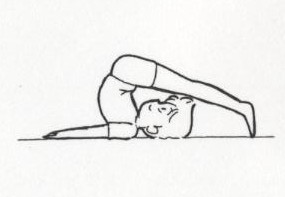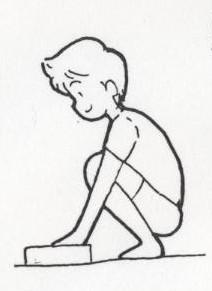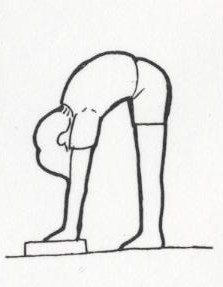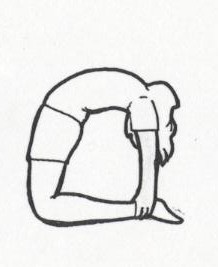![]()
..
■Improving Flexibility
−Katatsumuri(Snail), Crouching and Standing, Backward Stretch
What is the merit of being flexible? If you think about our daily life, you will understand that the importance of flexibility is not limited to physical exercise.
In physical exercise, a "flexible" body can move easily without using any unnecessary force.
What is the merit of having a highly flexible body? If your body is flexible, you can reach wider areas. You can easily achieve various movements such as extending arms, bending forward, and twisting the body. As your body does not require any unnecessary force, you won't get tired. A flexible body is also a body that won't get hurt so easily. If you have a stiff body, your movement is limited and clumsy, and you are likely to tumble down.
A flexible body also influences daily activities. Flexibility helps in achieving activities such as leaning forward to put on shoes, extending and bending various parts of the body to put on clothes, and cleaning the bottom while sitting on the toilet seat.
We hope that our children will be able to work their body well and fulfill
their daily life. Here are some everyday exercises for proper use of the
body that are effective in gaining flexibility.
●Katatsumuri(Snail)
Purpose
*Stretching the back
*Stretching the back of the whole legs
Lay down flat on the back. Raise the legs up and then bring them down so that the toes will touch the floor. When a child is not used to the exercise, sometimes he/she gets afraid when the legs come over his/her face. So adults should keep their hands above the face and guide where the legs should come down. If the child has a stiff back and he/she cannot touch the floor with the toes, change the objective and find something that his/her toes can touch. Consider the child's condition and point out changing goals e.g. starting with "touching the chair" to "touching something lower than the chair".
|
These are checking points for this exercise. ・Legs are closed and straightened. Figure 1
|
 Figure 1 |
Keep the "Snail" pose for 20-30 seconds, and repeat it 3 - 4 times. If the child returns to the original position slowly with the legs straightened, it will work out the abdominal muscles.
|
●Crouching and Standing
Purpose
*Stretching the back of the legs
*Stretching the ankles
At the start, open the legs wide to the width of the shoulders, then crouch. When doing this, the soles should be attached to the floor so that the ankle and calf muscles will be stretched. The toes should also be pointing forward and parallel to each other (figure 2). Put the palms on the floor, and straighten the legs (figure3). If the child's legs are still bent, support him/her by giving a couple of books or a low chair to put their hands on. As he/she practices several times, the back of the legs will be stretched, so you can arrange the height of the mount as you go. The position of the hands should be about 15 - 20 cm away from his/her toes. There are 2 checkpoints for this exercise.
・Straighten the legs.
・The palms should be attached to the floor.
Keep this pose for 10 - 20 seconds, and then crouch down to the starting position. Make sure he/she keeps the soles attached to the floor while doing so.
 figure 2 |
 figure 3 |
●Backward Stretch
Purpose Stretching abdominal and back muscles
Stretching shoulders
|
Start by kneeling. Bend the upper body backward and hold each ankle with the hands. Some children get afraid as bending backwards is an unusual movement. Adults can wait behind him/her and hold the head and guide his/her hands to each ankle. Here is a checkpoint of this exercise. ・Push the abdomen out forward.
|
|
If he/she does not push out the abdomen forward, it will look like a right angled triangle, and keeping the pose will require an undesirable force rather than help in creating the flexible body. If the child cannot reach out to his/her own ankles, place your thigh above his/her legs and ask him/her to touch it.
Keep the bending position for 10 - 20 seconds, and then return to the starting position. It can be a strengthening exercise for abdominal muscles if he/she keeps the hip upwards while doing so.
Above are three examples of exercises for a flexible body. It is important to work out everyday to gain flexibility. And most of all, it is important to have a basic muscular strength to support the body for continuing these exercises.
■From the monthly journal "The
Developmental Education"
The Association of Remedial Teaching for People with Developmental Handicaps

